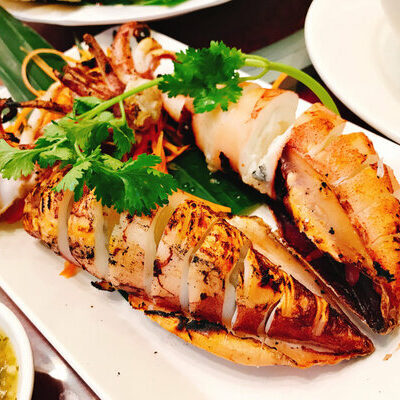
Squid
What is Squid?
Squid falls under the category of seafood. It is a cephalopod in the Decapodiformes superorder. This creature has a long body, large eyes, tentacles, and eight arms. Squid as food is popular throughout the world, and can be prepared in a variety of ways. It is eaten raw in Korean and Japanese cuisines, but is also popularly enjoyed as fried calamari.
- All parts of the fish are edible, except the beak and the pen.
- Squid ink is used to make delicacies in some cuisines, including a special type of paella.
The top 10 most popular squid dishes around the world include:
- Rabas (Spain)
- Kalamarakia (Greece)
- Ilayaki (Japan)
- Calamari Ripieni (Italy)
- Pla Muek Yang (Thailand)
- Chipirones en su tinta (Spain)
- Mực một nắng (Vietnam)
- Ojingeo Chae Bokkeum (South Korea)
- Ika Nigiri Sushi (Japan)
- Kalamar Tava (Turkey)
Origin of squid
This seafood developed around 500 million years ago. They have been eaten since ancient times by humans and there is archeological evidence that they were consumed in the Mediterranean region for at least 4,000 years. Also, they were popular in ancient cuisines of China, Japan, Korea, and other east Asian countries. This type of seafood was only introduced to other parts of the world over the last couple of hundred years. However, over the last 60 years, there has been a steady rise in consumption of it throughout the world.
Nutrition
Nutritional profile for squid (1 cup, steamed or boiled):

Squid is rich in phosphorus, potassium, sodium, selenium, and choline. Also, it contains calcium, magnesium, zinc, copper, vitamin C, niacin, folate, vitamin A, retinol, vitamin B-12, and vitamin E. Regular consumption of this dish may assist in lowering cholesterol. In addition, it contains essential fatty acids, which assist in maintaining cardiovascular health and promoting fetal growth.
Commercial production
The main exporters of squid are Thailand, China, India, Spain, and Peru. Squids may have a role in sustainable fishing in the future.
There are several methods for catching squid. It is an operation usually carried out at night because it allows the fishermen to attract them by using lights. One of the most common methods is jigging, in which metal jig lures are dropped into water for the squids to attack. Their tentacles get entangled on the spikes, and they are then caught and hauled up. Another method is to use large nets towards which the squid are lured to by lights. Also, bottom trawling technique is used for this purpose.
Squid must be cleaned and rinsed before storage. Then, it can be covered with a damp cloth to retain the moisture and sealed in an airtight container. This can remain fresh for up to 3 days and must be stored in the refrigerator.
Squid recipes
There are different recipes for squid, depending on their origin. Here are a few recipes:
- Nadan Koonthal Curry
- Makli Curry
- Calamari Pakoda
- Sambal Tumis Sotong
- Ketupat Sotong
- Sotong Masak Hitam
- Kenus Mebase
- Cumi Cumi Bakar
- Ikameshi
- Calamari in Zimino
- Black Tempura Calamari
- Caldillo de Mariscos
- Calamari à la Plancha
- Calamari Fra Diavolo
- Skrei
- Adobong Pusit
FDA regulations
There are no limits to the fishing and no seasonal restrictions on squid fishing in the US, according to the National Oceanic and Atmospheric Administration (NOAA). Although the FDA does not oversee the production of this fish, it does monitor Mercury levels in it. Also, it offers recommendations for consuming all types of fish and seafood.
References
Mouritsen OG and Styrbæk K (2018) Cephalopod Gastronomy—A Promise for the Future. Front. Commun. 3:38. doi: 10.3389/fcomm.2018.00038, https://www.frontiersin.org/articles/10.3389/fcomm.2018.00038/full
Tanaka, K et al. “Effects of dietary shrimp, squid and octopus on serum and liver lipid levels in mice.” Bioscience, biotechnology, and biochemistry vol. 62,7 (1998): 1369-75. doi:10.1271/bbb.62.1369, https://pubmed.ncbi.nlm.nih.gov/9720219/
Mouritsen, Ole G, and Charlotte Vinther Schmidt. “A Role for Macroalgae and Cephalopods in Sustainable Eating.” Frontiers in psychology vol. 11 1402. 7 Jul. 2020, doi:10.3389/fpsyg.2020.01402, https://www.ncbi.nlm.nih.gov/pmc/articles/PMC7358607/
